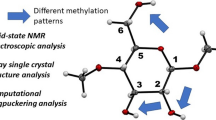Abstract
Cellulose I, mainly as ramie or as Avicel microcrystalline cellulose, has been monitored by optical microscopy and by 13C CPMAS NMR, over the course of its dissolution in hot N-methylmorpholine N-oxide solvent. Its interaction with the near-solvent N-ethylmorpholine N-oxide and related non-solvents has also been investigated. NMR shows that N-methylmorpholine N-oxide partly converts crystalline cellulose I into amorphous solid cellulose. The changes in chemical shift imply increased flexibility at the glycosidic bonds. In contrast, N-ethylmorpholine N-oxide converts cellulose I to cellulose IIII, without dissolution. Microscopy shows that the ramie fibres swell laterally, and at least some also shorten longitudinally, during dissolution. Model studies using methyl-β-d-glucopyranose show no evidence from 13C chemical shifts for different modes of binding with different solvents. However, N-methylmorpholine N-oxide binds more strongly to methyl-β-d-glucopyranose in DMSO than does N-ethylmorpholine N-oxide, whereas N-ethylmorpholine N-oxide binds better to H2O. Also, 13C T 1 values for aqueous cellobioside show increasing rotational freedom of the –CH2OH sidechains as N-methylmorpholine N-oxide is added. Together, these observations imply the initial penetration of solvents and near-solvents between the molecular cellulose sheets. Subsequently, N-methylmorpholine N-oxide breaks H-bonds, particularly to O-6, just sufficiently to loosen individual chains and then dissolve the sheets.
Similar content being viewed by others
References
Armstrong, R., Varga, J.K. and McCorsley, C. (1980) U.S. Patent 4, 196, 282.
Barfield, M. and Yamamura, S.H. (1990) Ab initio IGLO studies of the conformational dependencies of α-, β-and γ-substituent effects in the 13C NMR spectra of aliphatic and alicyclic hydrocarbons. J. Am. Chem. Soc. 112, 4747-4758.
Bock, K., Brignole, A. and Sigurskjold, B.W. (1986) Conformational dependence of the 13C NMR chemical shifts in oligosaccharides. J. Chem. Soc. Perkin Trans. II, 1711-1713.
Borisova, T.I., Afanas'eva, N.V., Burshtein, L.L., Borodina, O.E. and Golova, L.K. (1993) Dielectric absorption and molecular mechanisms of the initial stages of cellulose dissolution in N-methylmorpholine N-oxide: a dielectric absorption study. Vysokomolekularnye Soedineniya 35, A1326-A1331.
Chanzy, H., Noe, P., Paillet, M. and Smith, P. (1983) Swelling and dissolution of cellulose in amine oxide/water systems. J. Appl. Polymer Sci. 37, 239-259.
Chanzy, H., Henrissat, B., Vincendon, M., Tanner, S.F. and Belton, P.S. (1987) Solid-state C-13 NMR and electron microscopy study on the reversible cellulose I-cellulose IIII transformation in Valonia. Carbohydrate Res. 160, 1-11.
Cymerman-Craig, J. and Purushothaman, K.K. (1970) An improved preparation of tertiary amine N-oxides. J. Org. Chem. 5, 1721-1722.
Doddrell, D., Glushko, V. and Allerhand, A. (1972) Theory of nuclear Overhauser enhancement and 13C-1H dipolar relaxation in proton-decoupled carbon-13 NMR spectra of macromolecules. J. Chem. Phys. 56, 3683-3689.
Earl, W.L. and VanderHart, D.L. (1981) Observations by high-resolution carbon-13 nuclear magnetic resonance of cellulose I related to morphology and crystal structure. Macromolecules 14, 570-574.
Hemmingson, J.A. and Newman, R.H. (1995) Changes in molecular ordering associated with alkali treatment and vacuum drying of cellulose. Cellulose 2, 71-82.
Hobley, P., Howarth, O.W. and Ibbett, R.N. (1996) 1H and 13C NMR shifts for aldopyranose and aldofuranose monosaccharides: conformational analysis and solvent dependence. Magn. Reson. Chem. 34, 755-760.
Horii, F., Hirai, A and Kitamaru, R. (1984) Polymers for fibers and elastomers, ACS Symp. Series, no. 260 (J. C. Arthur, Jr., ed.). Am. Chem. Soc., Washington D.C., p. 27.
Howarth, O.W. (1979) Effect of internal librational motions on the 13C nuclear magnetic resonance relaxation times of polymers and peptides. J. C. S. Faraday II 75, 863-873.
Isogai, A., Usuda, M., Kato, T., Urya, T. and Atalla, R.H. (1989) Solid-state CP/MAS carbon-13 NMR study of cellulose polymorphs. Macromolecules 22, 3168-3172.
Kai, A. and Mondal, I.H. (1997) Influence of substituent of red dye having biphenylenebis( azo) skeletal structure on structure of nascent cellulose produced by Acetobacter xylinum [I]. Int. J. Biol. Macromol. 20, 221-231.
Kamide, K., Okajima, K., Kowsaka, K. and Matsui, T. (1985) CP/MASS 13C NMR spectra of cellulose solids: an explanation by the intramolecular hydrogen bond concept. Polymer J. 17, 701-706.
Larsson, P.T., Wickholm, K. and Iversen, T. (1997) A CP/MAS C-13 NMR investigation of molecular ordering in cellulose. Carbohydrate Res. 302, 19-25.
Michael, M. (1997) Ph.D. thesis, University of Warwick, UK.
VanderHart, D.L. and Atalla, R.H. (1984) Studies of microstructure in native celluloses using solid-state 13C NMR. Macromolecules 17, 1465-1472.
Wickholm, K., Larsson, P.T. and Iversen, T. (1998) Assignment of non-crystalline forms in cellulose I by CP/MAS C-13 NMR spectroscopy. Carbohydrate Res. 312, 122-129.
Woessner, D.E. (1962) Spin relaxation processes in a two-proton system undergoing anisotropic reorientation. J. Chem. Phys. 36, 1-4.
Wormald, P., Wickholm, K., Larsson, P.T. and Iversen, T. (1996) Conversions between ordered and disordered cellulose. Cellulose 3, 141-152.
Author information
Authors and Affiliations
Rights and permissions
About this article
Cite this article
Michael, M., Ibbett, R.N. & Howarth, O.W. Interaction of cellulose with amine oxide solvents. Cellulose 7, 21–33 (2000). https://doi.org/10.1023/A:1009263606864
Issue Date:
DOI: https://doi.org/10.1023/A:1009263606864




